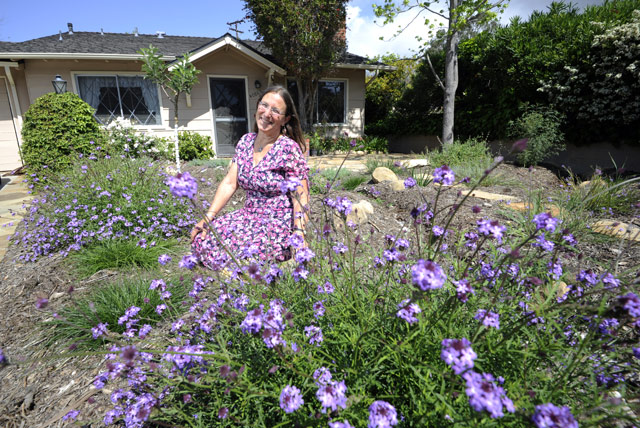Sweetwater Collaborative Are Water Wizards for Drought
Keeping Santa Barbara Backyards Beautiful Through the Drought

Barbara Wishingrad and her crew of water wizards at the Sweetwater Collaborative are teaching Santa Barbara drought-weary citizens that what is old is still new. Where City Hall is now spending $60 million on a new-yet-ironically-old desalination plant, members of the Sweetwater Collaborative are systematically redefining “beautiful” in very-old-but-still-new water-wise terms. Exalting a landscape Wishingrad describes as “The American Riviera,” the collaborative promotes native, drought-tolerant vegetation and water uses that have evolved over the centuries in semiarid environments.
“We’re talking about astonishingly beautiful gardens without using so very much of our water,” she said. “It’s not necessary to use 50 percent of our drinkable water on our landscaping and flush so much of it down the toilet.” And Wishingrad isn’t just talking the talk. The Sweetwater Collaborative offers hands-on, detailed instruction on how to use less water while doing more. Twice a month, Sweetwater runs 90-minute classes on how to capture “run-on” water rather than “run-off,” using simple, low-tech steps to redirect and store water that would otherwise race down gutters, and how to reuse the gray water that flows from Santa Barbara washing machines daily. In addition, the collaborative leads in-depth workshops on how to reconfigure Santa Barbara’s landscaped outdoor environment to effectively store rainfall. Once a month, Sweetwater hosts a workshop for landscape professionals. The whole intent, Wishingrad explained, is to capture water that would otherwise be wasted and “to slow it, to spread it, and to sink it.”
Even Sweetwater’s outreach campaign is old-fashioned. On bigger projects — actual top-to-bottom backyard permaculture makeovers that can include the creation of rain gardens, mulch basins, and down spout diversions — the group uses “the barn-raising” approach. People still learning the methods can earn sweat-equity discounts for their own projects by spending at least 20 hours transforming other backyards. Not only is that the best way to learn, said Wishingrad, but it fosters a greater sense of community.
In person, Wishingrad radiates the quiet, friendly formidability of someone accustomed to landing on her feet. Born in Chicago 62 years ago, Wishingrad, along with her mother and four siblings, moved to the San Fernando Valley in 1968 after her father, a doctor, died. Graduating high school at age 16, Wishingrad moved to Santa Barbara two years later to be with her then-boyfriend and work a gig teaching arts and crafts for the city’s Parks & Rec Department. Shortly thereafter, she bought a small herbal healing shop located at Victoria Court, eventually selling it and going off to study and to travel. While in Mexico, where she married, had two kids, and practiced herbal healing, Wishingrad lived without running water for a number of years. “I have experience with water supply that is different from most Americans,” she said. In 1998, she moved back to Santa Barbara, and in 2007, it dawned on her that water was about to become the new oil. She threw herself into sustainable watershed management and permaculture water management techniques and soaked up what she could learn at the Quail Springs Permaculture Farm and “learning oases” in New Cuyama.
She and five others formed the Sweetwater Collaborative shortly before the drought hit. “If there are so many committed environmentalists in Santa Barbara, how come our built environment didn’t reflect that more?” she wondered. They set out to answer that question, borrowing ideas from successful permaculture water management programs, and eventually embracing the hands-on approach because it was more effective and fun.
To date, city councils and water districts from Carpinteria to Goleta have contracted with Sweetwater to preach the gospel of rainwater management, landscape solutions, and the ABCs of graywater conversion. For property owners seeking to transform their yards, Wishingrad estimated it could cost between $5,000 and $12,000, but as much as $2,800 is available in rebates.
The Sweetwater methods also save the trees, many of which have died in the drought; far more are stressed and vulnerable. By directing otherwise wasted water to mulch basins, trees, whose roots help keep soil permeable, can be kept alive, thus increasing the carrying capacity of the earth itself.
In the long run, Wishingrad believes, properties that have made these adjustments will be better able to survive should the new “new normal” become prolonged drought. And, she noted, their property values will be enhanced.



